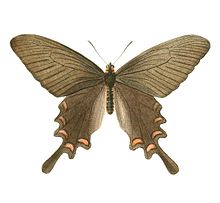Byasa alcinous
| Atrophaneura alcinous | |
|---|---|

| |

| |
| Scientific classification | |
| Kingdom: | |
| Phylum: | |
| Class: | |
| Order: | |
| Family: | |
| Genus: | |
| Species: | B. alcinous
|
| Binomial name | |
| Byasa alcinous[1] | |
| Synonyms | |
| |
The Chinese Windmill (Byasa alcinous) is a butterfly of the Papilionidae family.
Description
Byasa alcinous has a wingspan reaching about 9–10 centimetres (3.5–3.9 in). The basic colour of the wings is black or dark-brown.The hind wings have long tails and a chain of red spots at the edges. The thorax and the abdomen are mainly black on the upperside and the underside, with several black spots, while the other areas are red.[3] Adults are on wing from May to August in two generations.
The larvae feed on Aristolochia mandshhuriensis, Aristolochia debilis and Aristolochia manchuriensis.[3] Subspecies has been recorded on Aristolochia shimadai, Aristolochia liukiuensis, Aristolochia kankauensis, Aristolochia elegans, Aristolochia debilis, Aristolochia kaempferii, Aristolochia onoei, Aristolochia tagala, Cocculus trilobus and Metaplexis chinensis. The species overwinters as a pupa.[2][3]
Distribution
This species can be found in the Asian part of the Palaearctic ecozone and partially in the Indomalaya ecozone, from Bhutan, and eastern China to the southern Ussuri region, Korea and Japan.[3][4]
Habitat
Byasa alcinous is present in mixed broadleaved forests.
Subspecies
- B. alcinous alcinous
- B. a. confusus (Rothschild, 1895) (Ussuri)
- B. a. yakushimana (Esaki & Umeno, 1929) (Japan)
- B. a. loochooana (Rothschild, 1896) (Japan)
- B. a. miyakoensis (Omoto, 1960) (Japan)
- B. a. bradanus (Fruhstorfer, 1908) (Japan)
- B. a. mansonensis (Fruhstorfer, 1901) (south-central and south-eastern China, Taiwan) [3]
Gallery
-
Dorsal view
-
Ventral view
-
Caterpillar
-
Chrysalis
References
- ^ a b Häuser, Christoph L.; de Jong, Rienk; Lamas, Gerardo; Robbins, Robert K.; Smith, Campbell; Vane-Wright, Richard I. (28 July 2005). "Papilionidae – revised GloBIS/GART species checklist (2nd draft)". Entomological Data Information System. Staatliches Museum für Naturkunde Stuttgart, Germany. Retrieved 21 June 2013.
- ^ a b Funet.fi
- ^ a b c d e Butterfly Corner
- ^ Russian Insects
- Collins, N.M. & Morris, M.G. (1985) Threatened Swallowtail Butterflies of the World. IUCN. ISBN 2-88032-603-6 pdf
External links
- Global Butterfly Information System Syntype text, images of ssp. alcinous, nana, pacifica and parvummaculatus.
- Panoramio
- Atrophaneura_alcinous




